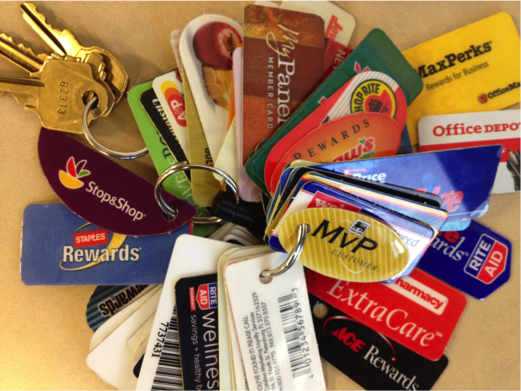How many retailer “rewards” card programs are you a member of? I’m guessing it’s more than one. In fact, I bet it’s likely more than 10. Nowadays, “rewards”, or loyalty programs as they are known, have become so ubiquitous, that the average consumer now has 12 little branded plastic tags attached to her keychain (or in her wallet, etc). But now, even with the tremendous growth in loyalty programs, the shopper-loyalty-card is dying. Let me explain.
Card based loyalty programs used to be the greatest thing; brands believed they were getting consumer loyalty and consumers believed they were getting a “deal.” But that’s just not the case anymore and there are several reasons why these “loyalty card” programs just aren’t working anymore:
Loyalty overload: In the grocery industry for example, almost every chain has its own card. These cards are simple to get since they don’t make me earn my savings by spending a certain amount or achieving a certain transaction frequency, and thus there is no reason why I shouldn’t have one for every store within 10 miles of me, which of course I do. I have a loyalty card for all of the nearby grocery stores hanging on my keys at all times, just so I never lose out if I go to one and not the other. This enables me to save money no matter where I go. And in exchange for being a “loyal customer,” I provide the retailer with a treasure trove of data about myself – name, address, email and all my purchase history, but see little or no value in exchange except that Buy One Get One offer I get if I purchase items they want to put on sale.
Customers aren’t engaged: According to National Center for Data Mining, more than half of loyalty program members are inactive; and this number is on the rise. While retailers may boast increasing membership in their programs, many of these customers have moved, stopped shopping at that store, lost their card, forgot they had a card, etc. It could even be that a consumer did not want to keep 20 cards on her keychain and thus stripped down to the top 2 and left the rest for dead in a drawer somewhere. This is certainly not helping to build any brand loyalty.
The rewards are too complicated: On the other end of the spectrum are retail loyalty programs, such as DSW. At DSW, members get a paper coupon in the mail every time they accumulate a certain amount of spending points on their accounts. But the paper coupons are easy to forget or lose, and oftentimes end up being an absolute hassle for the customer. In a recent study by Loyalty One, less than half of customers agree with the statement, “The program makes it easy for me to redeem for a reward.”
Disloyalty is rewarded: An efficient retail loyalty program essentially becomes the opposite of loyalty. Retailers are better off extending richer rewards to the worst customers, not the best and most loyal. Stores can already rely on fully engaged loyal customers to shop and spend. New sales and market share growth can only come from one thing; and that is to convert brand agnostic shoppers into loyal ones – and to do so, these disloyal customers must receive richer, targeted offers and incentives in an effort win their business.
Enter credit-linked offers (CLOs). From the consumer perspective, CLOs offer a better, more seamless and more practical experience. There is no need to print coupons, clip coupons, remember to bring a little punch card around everywhere you go or have 12 little plastic cards bulking up your keychain. CLOs also significantly reduce the hassle on the retailers’ end because CLOs eliminate the need for a retailer to collect paper coupons, categorize them, mail them into a clearing house and wait to be repaid. And for those advertisers out there, CLOs enhance your ability to target customers, track attribution, and control redemption; making the most out of promotional dollars. It is a win-win for all involved.
Given all of this and the fact that consumers are looking for ways to save on items from food to clothing to gas, it’s easy to understand why the couponing industry is exploding. As retailers become more sophisticated, data becomes increasingly more important and consumers become more and more comfortable using their mobile devices, card-linked offer will only continue to increase and become a more important vehicle in the advertising arsenal.


